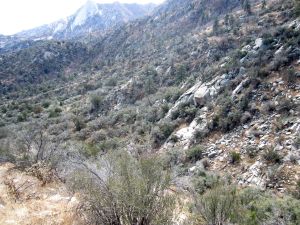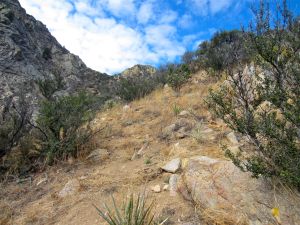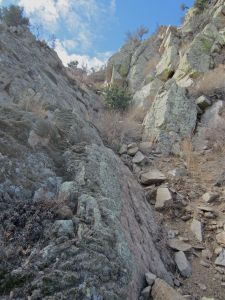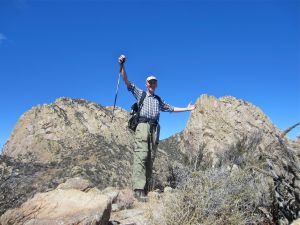Overview
The route begins with a hike along Anvil Creek on the Pine Tree Trail, departs into an arroyo, climbs out on the flanks of a tall rib, and finishes with a rib ramble to Windy Gap. Smart hikers will then return the way they came. This route description pauses to reflect on the perils of poor situational awareness. Then it describes the horror (“the horror”) of a traverse from Windy Gap south to Sotol Creek via impenetrable mountain-mahogany thickets.
The portion of the route that is a mild scramble to Windy Gap is strongly recommended for those hikers who are in good shape. The portion of the route that is a thicket traverse comes recommended only for those people who may have done you irreparable harm.
Driving Directions (and study guide):
The driving directions are the same as for the Pine Tree Trail in the Aguirre Springs Campground. Park at the trailhead for Pine Tree Trail. On Aguirre Springs Road, look for the Rabbit Ear spires that dominate the northern Organ Mountains. South of the Rabbit Ears look for a wide pass that is Windy Gap. South of Windy Gap watch the terrain make a brisk climb up Gretch’s Folly to the Lower Horns. Make particular note of a prominent rib (alternatively called a “hogback”, “buttress” or “welt”) that descends from Windy Gap towards you in the Tularosa Basin. You will be parking your car on the fall line of that rib and then hiking an arroyo that descends from Windy Gap along the far side of the rib. I haven’t seen a formal designation for this buttress, so here it will be called Aguirre Springs Rib.
Trailhead:

The mighty Camry parked below Aguirre Springs Rib (slanting down from upper right) and the Lower Horns (in the distance).
The Pine Tree Trail trailhead is in Aguirre Springs Campground and is signed. There is a trash receptacle, picnic tables and nearby pit toilets. It costs $5.00 per car to park for the day, 2.50 if you have one of the Federal passes. If your plans are more complex than just a day hike, see the trailhead section in the Pine Tree Trail post.
Data:
The map shows the ascent route in blue. The descent route, going south into Sotol Creek Bowl, is shown in black. The portion of the Pine Tree Trail that was not used on this route is shown in purple.
- Starting Elevation: 5680 feet
- High Point: 7450 feet (at Pass)
- Net Gain: 1770 feet
- Distance to Windy Gap: 1.9 miles (one way)
- Distance from Windy Gap to Sotol Creek and back by Pine Tree Trail: 3.8 miles (one way)
- Map: USGS Organ Peak quadrangle
Hike Description:
From the trailhead, ascend the stem of this lollipop route and arrive at the loop portion in less than 1000 feet. At this point you have left the fall line of Aguirre Springs Rib and are almost in the bed of Anvil Creek. The joys of this well maintained trail are described in the Pine Tree Trail post, so here it should be enough to say “go right (counterclockwise)”.

View of the northern-most Lower Horns (left) and the south side of Aguirre Springs Rib (right) Note the light-colored rocky side buttress on ASR and the more distant green buttress. The latter has a white, tooth-like spire at its foot.
Follow the trail as it ascends along Anvil Creek. Keep an eye on Windy Gap, which will frequently be in sight. You want to keep the Aguirre Springs Rib either under your feet or immediately on your right. The south side of Aguirre Springs Rib is cut up by several small drainages that feed into Anvil Creek. One such drainage, well above the loop, is marked by a whitish rocky outcrop that runs along its bank top. Beyond and above that is a second drainage that has more soil and is greener. Near the foot of this green bank-top is a tooth shaped spire of white rock. The ribs and the tooth-shaped spire can be useful markers later in the scramble.
The departure from the trail to the scramble is not marked. At just over a mile from the trailhead the tread crosses a minor drainage by contouring slightly right. Then, in the bed of the drainage, the trail makes a hard left. In just 30 more feet the trail bends 90 degrees to the right to go around an 8-foot tall boulder. Just past these twists the trail enters the bed of a big arroyo that feeds Anvil Creek. In another twenty or thirty feet the Trail leaves the arroyo bed and heads south (purple line in the map). Here, leave the trail for the arroyo bed. The trick is to identify this rapid sequence of a hard-left, a hard right (around boulder) and entrance into the arroyo.

Ascending past the whitish, toothlike spire at the foot of the green buttress as you ascend the arroyo
At 1.25 miles from the trailhead begin ascending the arroyo and picking a way past boulders and over downed limbs. The bed is deeply shaded and cool. There was no water in it on this late-winter day. Occasionally the tree limbs accumulating in the creek bed will force you off to one bank or the other, but it is useful to stay in the bed for as long as you can. Watch the drainages coming down off of Aguirre Springs Rib. You will quickly pass two candidates that could be that drainage that was topped by a whitish rocky outcrop. At 1.5 miles from the trailhead you will pass the green-topped drainage. You will get a good view of the tooth-shaped rock spire, which up-close seems rather crooked.
Shortly past the spire the trees becomes densely packed on the bed of the canyon. The north-facing wall on your left becomes high-angle rock slab. Turn right and ascend the steep south-facing wall of the canyon. The angle is shallow enough to retain soil and there is some plant growth. The chief problem is that the soil is very loose and climbing the slope is like climbing a steep-sided sand dune. Switchbacking does help.
At 1.6 miles reach the fall line of the rib and turn uphill. This begins a long process of dodging prickly pear and cholla cacti, various forms of agave, sotol and yucca, and the occasional alligator juniper. The ascent is steep, although not generally as steep as the walls of the flanking arroyo. One exception occurs as you approach Windy Gap. Here the rising rib slightly over-shoots the saddle point of the pass, leaving a bump rising above the main col. It is a puzzle how to get around the bump since it is rather steep sided. If you go right (towards the Rabbit Ears) you will find a steep gully with convenient hand-holds that will take you to the top. At 1.9 miles, arrive at the bump-top in Windy Gap.
This is a terrific place for a tired scrambler to have lunch and admire the views. To the west lies Las Cruces, the West Potrillo Mountains and the distant Florida Range. To the east lie White Sands Missile Base, the Tularosa Basin, the Sacramento Mountains, White Sands, and even sight lines to Sierra Blanca. But the stunner views are north to Rabbit Ear Massif and the Rabbit Ears, and south to the spires of the Lower Horns. There seem to be approaches, perhaps practicable, in both directions. Smart scramblers might take notes for future reference and return the way they came. That way you could return directly to the car (about 4 miles, round trip), or continue following Pine Tree Trail for a great six-mile day.

View to Sugarloaf (distant) and the rib that separates Anvil and Sotal creek basins. Do not forget to scrutinize the close-in terrain. (Double click to enlarge)
Alternatively, those of us who are somewhat new to this kind of terrain might allow their gaze to ride south across the Anvil Creek Bowl. There, just below the rib that separates Anvil Creek Bowl from Sotol Creek Bowl, you might discern open parkland, lightly forested, within easy reach. If you do, then you are wrong. Study the intervening ground carefully. You will note that your line of sight extends all the way to the grass covered ground in that open park land. Closer in, however, the ground below the Lower Horns is densely covered with a haze of gray-green stuff. Also, that gray-green area has odd contrasting lines that seem to go straight down hill. What is this striated, gray-green terrain? Let’s find out, shall we?
Descend south (toward Gretch’s Folly) from the bump top to the col that forms Windy Gap. On the col, face east towards the Tularosa Basin. Here you stand at the head of the arroyo that you followed up from Pine Tree Trail. Pick your way down the arroyo, threading your way between increasingly dense gray bushes and past granite slabs.

Notch in the wall on the south side of the descent arroyo, directly below the Lower Horns cliff line.
Gray. Hmm. Sounds familiar. The terrain is not bad initially and you may be distracted by the loose sandy footing. It’s actually quite fun. Stay to the south side until reaching a cliff-like slab traversing the arroyo. At the slab top, track back towards the Aguirre Springs Rib, never straying far from the arroyo bed. After descending about 1000 feet from the bump, however, the thick bushes in the arroyo floor became a major barrier to progress. Scan the south wall for a small notch in the rock and head for that. From this notch there is a view into a broad waterway descending from the northern-most Lower Horns. Getting there entails a descent of a granite slab in a minor gully (barely a gutter) that offers occasional hand holds. The slab is not very steep, but the lower end is lined with stout and pointy agave so exposure is unexpectedly high). Below the slab find a nice shelf, only a little brushy, and follow it into the waterway. Ascend the far side to a lonely pine sentinel. There, look south, hoping for an easy ramble through high-country parkland.
Never so lucky! press into more gray green brush, watching for cactus, snakes, thorn bushes, and thigh-murdering agave plants (often screened by dead vegetation). Remember those lines you saw in the gray-green area below Windy Gap? Each one of those was a small rib separating minor water courses. If you have a good memory you may recall having seen at least six of these lines. In practice, there are about ten. On each one you bash over the small rib, descend past more boulders, down slabs, around cholla, pincushion, hedgehog and prickly pear cacti, deflecting more agave, sotol and yucca, all for the simple and light hearted purpose of pushing your way deeper and deeper into oak thickets, mountain mahogany thickets, and mixed thickets leavened with rare instances of what appear to be Texas Madrone. Arriving at the bed of the next water course, prepare to do it again.

Crisp silhouette of author’s index finger (blocking sun) and pretty good view of scrubbed-bedrock canyon bottom.
After 0.8 long miles, arrive in the scrubbed-bedrock floor of the major waterway descending from the Lower Horns into Anvil Creek. It is a sunny and wonderfully open place. Stop for water, some calories, and a chance to ponder your sanity. You have the option, I think, of descending this waterway. It should take you back to Pine Tree Trail and an easy amble to the car. If, on the other hand, you are possessed of a belligerent attitude towards your personal happiness then cork that canteen, pick up that pack, push up over the canyon wall and into the welcoming branches of the next thicket.
Fortunately it is almost impossible to get lost here. Views into the vast Tularosa Basin on your left are almost constant. The large rib that separates Anvil Creek from Sotal Creek is usually visible in front of you. You will have views beyond this rib to Sugarloaf as well. The Lower Horns loom spectacularly above and to your right. If you loose sight of Sugarloaf then a quick glance backward should show you the Rabbit Ears. Plunge on.
..
Actually, after the big drainage the brush starts to thin out a bit. Small clusters of big pines appear. Wonderful game trails start to crop up. Two of the small drainages on this date had flowing water in them. There are bushes still, never fear, but the route up to the high point on the Sotol/Anvil rib becomes clearer and clearer. Arrive at the the most prominent bump on this rib in just over a mile from Windy Gap – shaken and stirred. If you were to descend from the rib south into Sotol Creek Bowl you would hit the Pine Tree Trail in about 200 feet. Unaware of this fact, I turned downhill and followed the rib until it struck the trail, adding about a quarter mile to the total. Turning left on the trail (towards the Rabbit Ears) will get you back to the trailhead quickest, while turning right will allow you to complete the loop part of the trail. Turn right, enter Sotol Creek Bowl, and enjoy a meticulously maintained freedom from cactus spines.
The rest of the hike on this trail has been described elsewhere. After 3.8 miles from Windy Gap, return to the trailhead.
Recommendations:
Do not bother with the traverse. Repeat as needed.
There was quite a display of small lizards on this hike, but no other reptiles. The weather is still pretty brisk up high (it was spitting snow at the trailhead on Saturday morning), but the approaching warm weather should soon bring out a few a few of our sinuous mountainside friends.
The bump atop Aguirre Springs Rib has truly exceptional views. I saw one patch where a very small tent could be pitched up there. There could be a rare display of stars on a nice April evening. The camping would be entirely dry.
Outside Links:
The inspiration for this exploration was OnWalkabout’s description of a venture to Windy Gap (although OW didn’t reach the ridge line). That post has great photos of the Horns taken right at cliff line and shots of a descent passage on scrubbed-bedrock canyon floor. Readers should consider, however, the possibility that the author of that report got slightly off of his mapped route. The ascent described here never went directly beneath the spires, nor did the ascent ever follow a bedrock waterway. Instead, those features were encountered on the southerly traverse away from Windy Gap. My guess is that OW departed from Pine Tree Trail beyond the arroyo and nearer the main bed of Anvil Creek. If so, then OW must have pushed steeply uphill through appalling thickets on lousy footing. That blog’s assertion that “the going became tough” may be the ne plus ultra in hikerly understatement.
Southern New Mexico Explorer has some comments about ascending to Windy Gap from the other (i.e. western) side of the Organ Mountains. It sounds brutal!
The daily paper in Las Cruces, the LC Sun-News, has a write up concerning the names of various Organ Mountain summits and spires, as well as commentary on how obscure the background to the names can be.
That article refers to an image in The Mountain Project that labels the peaks in the Organ Mountains. That site also has a second image with labels for features near the Rabbit Ears and Rabbit Ear Plateau (sometimes called Rabbit Ear Massif).
The “Peak Locator” in R. L. Ingraham’s “Climbing Guide to the Organ Mountains” shows much the same information. (The Guide was printed in 1965 and is clearly dated in places. Still, it is a huge resource and my thanks to R. A. Hahn for adapting it to the web and NMSU for supporting it).











